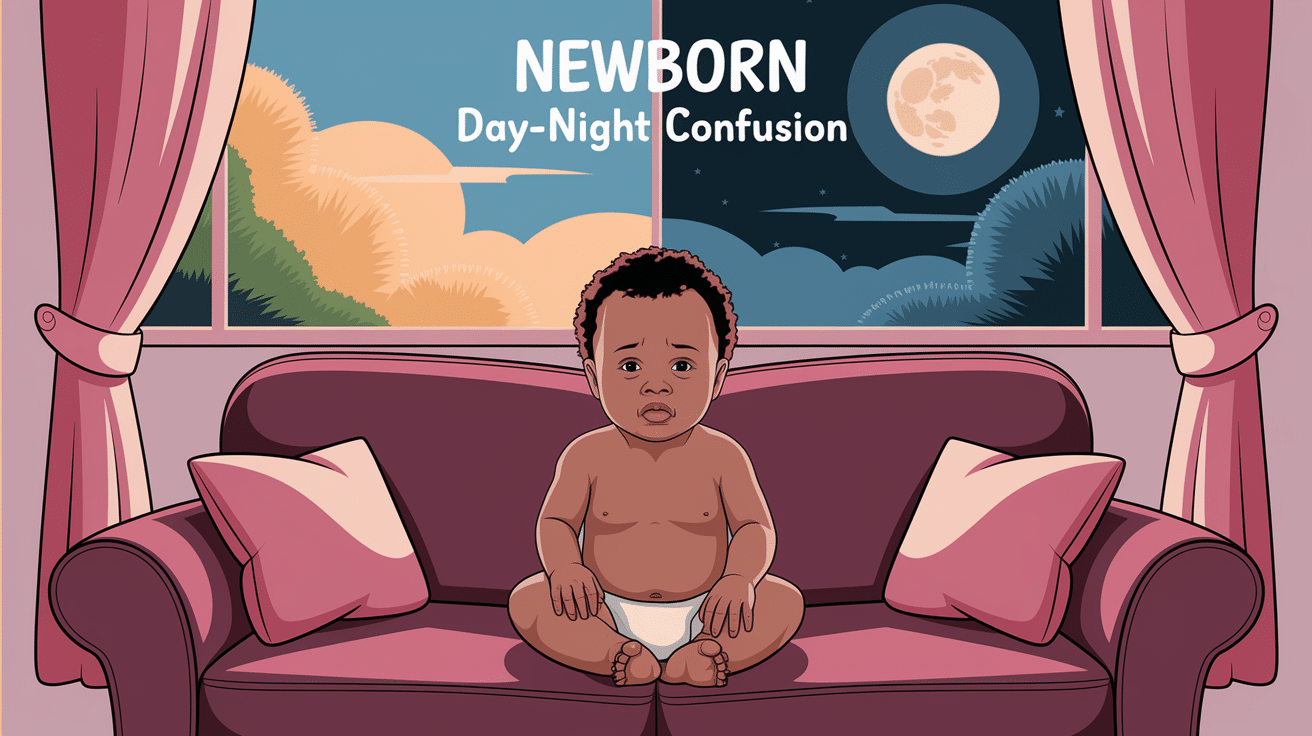
Are you stumbling through midnight hours with wide-awake eyes staring back at you while your baby snoozes peacefully all day long?
You’re not alone! Newborn day-night confusion is one of parenthood’s most challenging puzzles, leaving exhausted parents wondering if they’ll ever sleep again.
This frustrating but completely normal phase happens when babies haven’t yet figured out that nights are for sleeping and days are for being awake. Their tiny bodies are working on developing the internal clock that will eventually help everyone get more rest.
The good news? This won’t last forever! With some simple strategies and a bit of patience, you can help reset your baby’s confused sleep schedule.
Understanding this common newborn challenge opens the door to practical solutions for those sleepless nights and restful days ahead.
What is Newborn Day-Night Confusion?
Newborn day-night confusion occurs when babies sleep more during the day and stay awake at night. This common issue occurs because babies haven’t yet developed their internal body clock, which tells them when to sleep and when to be awake.
While in the womb, babies often experience movement during the day (which rocks them to sleep) and stillness at night (when mom is resting), creating reverse sleep patterns.
Unlike adults who cycle through light and deep sleep over several hours, newborns move quickly between sleep states, with shorter sleep cycles lasting only 40-50 minutes.
They also spend more time in active REM (Rapid Eye Movement) sleep, which is why they twitch, smile, and appear restless while sleeping.
Adults typically follow a predictable 24-hour rhythm governed by daylight and darkness, but newborns need time to develop this pattern. Most babies gradually adjust their sleep cycles within the first two to three months of life.
Why Does Day-Night Confusion Happen?

Day-night confusion occurs mainly because newborns haven’t developed their circadian rhythm yet—the internal clock that helps us know when to sleep and when to be awake.
Before birth, babies live in constant darkness inside the womb, where they don’t experience the normal day-night cycle that regulates our sleep patterns. In this prenatal environment, babies often sleep when their mom is active (being gently rocked by her movements) and become more active when she’s resting.
After birth, newborns need time to adjust to the outside world where light and darkness alternate. They haven’t learned to recognize these natural light cues that signal when it’s time to be alert or sleepy.
Additionally, frequent feedings every 2-3 hours around the clock further disrupt any developing sleep pattern. The good news is that with consistent exposure to daytime light and nighttime darkness, most babies begin developing their circadian rhythm by 6-8 weeks, though complete adjustment may take 3-4 months.
Signs Your Newborn Might Have Day-Night Confusion

You might notice that your baby has day-night confusion if they show certain patterns in their sleep behavior. The most obvious sign is when your baby sleeps for long stretches during daylight hours, sometimes taking multiple extended naps that can last 3-4 hours at a time.
Then, when evening arrives and you’re ready for rest, your baby becomes surprisingly alert, wide-eyed, and ready to engage.
Nighttime fussiness is another common indicator—your newborn may cry frequently between 10 PM and 4 AM despite having all its needs met (clean diaper, full tummy, comfortable temperature).
You might also notice that your baby fights sleep at night, squirming and crying when you attempt to put them down in their bassinet or crib. While you’re exhausted and yearning for sleep, they seem determined to stay awake.
Your baby may only take short catnaps at night rather than the longer stretches of sleep you’re hoping for, which can lead to exhaustion for the whole family.
How to Fix Day-Night Confusion

Helping your baby sort out day-night confusion takes patience and consistency. Most babies will gradually adjust their sleep patterns within a few weeks. With some simple strategies, you can help speed up this process.
Remember that this is temporary, and your baby will eventually learn to sleep better at night. Here are four effective approaches to help reset your newborn’s internal clock.
1. Create a Daytime Routine
During daytime hours, keep your home bright, and don’t worry about everyday noises. Open curtains to let natural sunlight in, especially during morning feeds. If weather permits, take your baby outside for short periods.
Talk to your baby in normal tones during daytime feedings and diaper changes.
Keep your baby engaged during wake windows with age-appropriate activities like tummy time or simply looking at high-contrast items. Avoid letting your baby take very long daytime naps.
2. Nighttime Environment Tips
Keep evening activities calm and the lights low to create a clear difference between day and night. Use dim night lights or red-spectrum lights for nighttime feedings and diaper changes.
Speak in hushed tones during night wakings. Avoid play or excitement before bedtime to minimize stimulation.
Swaddle your baby (if safe and age-appropriate) to help them feel secure. Consider using white noise to mask household sounds that might wake your baby during light sleep cycles.
3. Feeding Strategies
Try to make daytime feedings social and interactive while keeping nighttime feedings businesslike. Consider cluster feeding in the evening to help your baby stay fuller longer during the night. Avoid playing or making eye contact during night feedings to signal it’s sleep time, not playtime.
Wake your baby for daytime feeds if they sleep more than 3 hours, which helps ensure they get enough calories during the day rather than at night. Gradually stretch the time between nighttime feedings as your baby grows.
4. Bedtime Rituals
Start a simple, consistent bedtime routine even with a newborn. Your routine might include a warm bath, gentle infant massage, changing into sleep clothes, swaddling, feeding, and softly singing or reading a book.
Keep the routine short (15-20 minutes) but consistent every night.
Begin your routine at roughly the same time each evening. Follow the same steps in the same order each night so your baby learns to recognize these cues for sleep. Be patient—it takes time for babies to learn these sleep associations.
When to Seek Professional Help?

While day-night confusion is normal for newborns, some situations require a doctor’s help. Call your pediatrician if your baby rarely sleeps at all. Be concerned if your baby seems to be in pain when trying to sleep.
Watch for breathing problems like pauses, loud snoring, or gasping. Poor weight gain is another reason to seek medical advice. Excessive crying that doesn’t improve with sleep routine changes also warrants attention.
Most babies should sort out day-night confusion by 3-4 months. If sleep problems continue past this time, talk to your doctor. For sleep issues that aren’t medical but still cause family stress, consider a pediatric sleep consultant.
These experts can create sleep plans just for your baby. They offer advice for specific problems and support you through the process. They understand different baby temperaments and parenting styles.
Summing It Up
The phase of newborn day-night confusion is temporary, but it can feel endless when you’re in the middle of it.
Remember that your baby isn’t trying to exhaust you—they’re simply learning how to exist in a world with cycles of light and dark.
Each small step you take to establish day and night patterns moves your family closer to more restful nights. The consistent routines you create now build the foundation for healthy sleep habits that will benefit your child for years to come.
Most importantly, be gentle with yourself during this challenging time. Even on the toughest nights, know that your baby is gradually developing their natural sleep rhythms.
Before you know it, those peaceful nighttime slumbers will extend, and the newborn day-night confusion will become nothing more than a memory in your parenting experience.
If you’re interested in more informational content on mothers and babies, feel free to click here and explore other blogs that you might enjoy.

